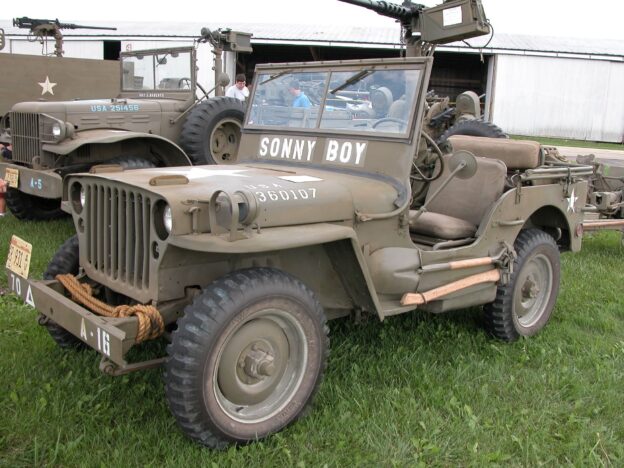
World War II: Willys-Overland and Ford Military Jeeps

Willys-Overland and Ford produced the iconic 1/4-ton 4×4 military trucks, commonly known as the “Jeep”, during World War II. These versatile vehicles, specifically the Willys MB and Ford GPW models, became symbols of American ingenuity and wartime resilience. Designed for reconnaissance and transportation, these military jeeps were rugged and reliable, making them invaluable on various terrains across the world.
Key Features and Specifications
Willys-Overland and Ford built their military Jeeps to be light, compact, and versatile.
- Weight and Size: Weighing around 2,300 pounds, the Jeep was compact but sturdy, able to carry up to 800 pounds of equipment or personnel.
- Engine: Both Willys and Ford models used the “Go Devil” 4-cylinder engine, known for its durability and ability to generate 60 horsepower.
- 4×4 Capability and Ground Clearance: The Jeep’s four-wheel-drive system and high ground clearance allowed it to handle mud, sand, snow, rocky ground, and other challenging conditions.
- Flat Fenders and Fold-Down Windshield: The Jeep’s flat fenders allowed soldiers to stand on them or place items on them when needed. Soldiers could lower the fold-down windshield to reduce the vehicle’s height, making it less conspicuous and easier to transport.
- Open Body Layout: The open design allowed for quick access to and from the vehicle and accommodated various battlefield roles, from troop transport to cargo hauling.
- Interchangeable Parts: Since Willys and Ford shared the contract to produce these vehicles, they built them to identical specifications, making parts interchangeable. This was crucial for field repairs and logistics during wartime.
Production and Logistics
Production was efficient and designed to meet the military’s needs.
- Total Production: Willys-Overland produced around 363,000 MB models during the war, and Ford produced around 277,000 GPW models.
- Standardization: Willys and Ford standardized components and followed the same technical specifications set by the Army.
- Cost-Cutting Measures: Ford adopted a stamped steel grille, replacing the original slat-style grille. This iconic Jeep feature reduced manufacturing time.
- Mass Production Techniques: Ford leveraged its experience with mass production from its work on civilian vehicles and applied their assembly-line techniques to meet the production rates required of the Willy-Overland and Ford military jeeps.
- Adaptability to Warfront Needs: They made minor design modifications, such as weapon mounts and radios, throughout production based on feedback from soldiers in the field. Some were also fitted with brackets for stretchers to serve as ambulances.
- Support for Allied Forces: The Jeep was not only used by U.S. troops but also supplied to Allied forces through the Lend-Lease program, particularly to Britain and the Soviet Union.
- Transport and Deployment: Jeeps were designed to be transported easily, often shipped overseas in large quantities or, in some cases, air-dropped in pieces for assembly on the ground.
Uses and Operations
The Jeep’s basic and customizable design allowed soldiers to use them in various missions and locations.
- Reconnaissance: With the size and agility of the Jeep, soldiers used them to scout and patrol without drawing too much attention.
- Communications: Soldiers equipped some Jeeps with radios for on-field communication amongst themselves and nearby units.
- Medical Support: The Jeep’s bracket fitment and flat design made room for stretchers and medics for on-field treatment and swift transportation from the battlefield.
- Personnel and Cargo Transport: Due to the Jeep’s payload, it could easily transport soldiers and supplies and tow small trailers to and from the battlefield and outposts.
- Light Combat: Jeeps with gun mounts provided soldiers with a mobile form of combat, allowing them to respond to threats both on the ground and in the air.
- Airborne Missions: Cargo planes air-dropped the Jeeps in pieces for airborne units to assemble upon landing to give the soldiers better mobility.
Legacy and Impact
The success of the 1/4-ton 4×4 truck production effort showcased the U.S. industrial power and established the Jeep as a standard for utility vehicles. The production collaboration between Willys and Ford set a precedent for high-volume, high-speed production that had lasting impacts on military logistics and the automotive industry. The vehicle’s adaptability and reliability helped them fulfill numerous roles during the war, making them indispensable for the U.S. military and allied forces. This versatility and success in different roles laid the foundation for the Jeep’s post-war transition to civilian markets and enduring legacy.
Interested in restoring an old military jeep or classic car? Find out more about car restoration and budgeting in our other blogs! You can also find the Willys-Overland and Ford Military Jeeps repair manual here.
Image credits: 1942 Willys Jeep by D. Miller on Flickr

 Shop Store
Shop Store











